Marketing for small businesses: A practical intro guide to starting your lead flow (it’s not just ads).
Marketing may seem elusive for small businesses. So here’s a guide to simplify and kickstart your efforts.

As a small business owner or co-founder you must’ve thought about marketing. But it can be difficult to understand and get a grip on all the options and where to begin. Let’s understand the why, what, and how in small business marketing to get you started.
What is the role of marketing in small business?
Once you have a fair customer base, an approximate product market fit, and a sales team, it’s a good idea to invest in marketing. The first marketer you hire or someone who naturally evolves into this role will have a lot on their plate while figuring out using different channels. For a small and growing business, marketing helps spread the word about your product. This is achieved via organic channels like SEO, social media, partnerships, or paid channels like advertising. When starting, it’s unlikely that most small businesses will have a competitive edge over other players in the market so a focus on good service, unique offerings, and promotional offers helps spread the word. While revenue is the hard measure to tell if your marketing is working, initially, softer activities around building a community and spreading the word makes more sense.
Who should be on your marketing team?
First, you should look to hire someone who knows marketing funnels and is good at creating content with about 3-5 years of experience. This person can pick up details of your business, form a communication style, and grow along to a senior position when the time comes. If your product is not knowledge-intensive i.e., they’re simple and generic consumer or software products, you can hire freelancers for content creation. Other things like content strategy, brand messaging, social media, campaigns, newsletters, etc, are best handled by someone within your company. So, initially get one person, then, build out a team with members to focus on specific areas like say, writers, video creators, social media evangelists, community evangelists, designers, etc.
First, understand where lies your business
With so many different ways and buzzwords in marketing, small businesses often are in a dilemma of where to start. SEO? Social media? Website? We’ll cover the basics of all these topics to help you get started. But first, you need to figure out what kind of business you’re in by asking questions like:
- A local shop/business?
- A software startup?
- Physical products in stores or eCommerce?
- B2C or B2B?
Once you’ve narrowed down your stream of business and identified if you’re customer-facing or business facing, you can identify which channels may work best for your business. We’ll cover this in more detail in a later section. For now, let’s get familiar with the most common ways to start.
Creating an online presence as a small business
Whether you’re a software business, a local bike shop, or a factory machine manufacturer, having an online presence is undeniably a must-have in today’s digital world. Having an online presence doesn’t always mean having a website, it won’t make much sense in certain cases like a local bakery. We’ll understand more in the following subsections.
Get a website
36% of small businesses don’t have a website.
Creating and hosting a website for your small business/company shows that you’re serious. Other than showcasing your brand style, putting out blogs, landing pages, about your company, products, and services, just the fact that you have a decent website gives your company some credibility. Note that I said decent since having a bad website just for the sake of it is worse than having no website at all. If you’re a really small/local business keen on having a website, you can make use of ‘Google business sites’. Websites don’t make much sense if you’re a local shop/gym etc, but it’s a must if you’re in the software or eCommerce industry.
The first thing to do is get a domain registered, it's the URL that people will enter in their browser, like erpnext.com. Popular services to rent/buy domain names are NameCheap and GoDaddy.
Once you have a domain, setting up the website with web pages is the next step. You could opt for partially free services WordPress and Wix. Shopify is popular for eCommerce websites. If you go for an all-inclusive platform like ERPNext, you get a website builder anyway.
Capture visitor information
When you have a website, the next step is to entice the visitors to buy or capture their contact information. There are multiple ways to do this—create eBooks, whitepapers, a newsletter, templates relevant to your industry, a free trial if you’re a software product or anything else for which the visitors may want to give their contact information.
The best way to capture visitor information is via web forms and categorizing them as leads. Note that just because someone downloaded an offering or subscribed to your newsletter doesn’t mean that they’re ready to buy from you. Hence pre-qualifying leads and understanding them is an important step before approaching them for sales. If you’re an eCommerce business, sending your audience offers and discounts might nudge them to buy.
Social media pages
“96% of small business owners/marketers use social media marketing” according to a Social Media Examiner report.
Small businesses initially can’t take the overhead of maintaining a website or in some cases, it doesn't make sense to get one. Either way, you should create and promote a social media page where you talk about your product and engage with your potential customer base.
Different social media platforms attract different types of users. Understand where your audience hangs out. The younger generation in their teens and 20s use Snapchat, Instagram, Pinterest, etc. More serious and B2B audience can be found on LinkedIn. Facebook is kind of a mix of both worlds but there is a shift in the way people use Facebook now according to their reports. A lot of older users (40+) use it. YouTube however is a great channel to reach a variety of audiences since people from all ages and backgrounds watch YouTube videos.
Here’s an example of ERPNext’s LinkedIn page where we share blogs like this one and other updates.

Listings with vendor websites
Most industries have peer review websites or services that provide listings and directories. Restaurants have Yelp and Zomato, software companies have G2 and Capterra, and for physical products, there are eCommerce platforms. Listing your company/business with such services increases visibility and potentially drives more sales. Here’s an example of ERPNext’s G2 page where users leave their reviews and do discussions.

Depending on your industry, there are different listing websites like yelp, zomato, craigslist, justdial, etc.
Even though people use a lot of social media, email still remains a personal and very widely used medium. This is especially true if your audience consists of an adult population. With emails, you can nurture leads by setting up welcome sequences when they download or join something, drip emails if they start a software trial, and so on. For example, if you sign up for an ERPNext account, you’ll see drip emails or get approached by a representative since you’ll have become a lead.
Webinars
Free webinars showcasing your product to solve customer problems is a great way to spread awareness and engage audiences live. Put a face to your brand, answer the audience’s questions, take feedback, etc. In the initial days, it’s best if the founder or co-founder hosts webinars, it helps connect with your small and growing audience.
Track site analytics
Once you have a site up and running you’d want to know how many visitors are coming each day, week, and month. The most widely used tool for this is Google Analytics. It’s free and provides a huge variety of data on where your audience is coming from, which countries, what age groups, and you can also set up goal tracking to find out how many conversions happened on your website. You need to copy-paste the Google Analytics tag to every head section of your website. It’s done easily in website/content management systems like WordPress and ERPNext since there are dedicated settings for it. There’s also Google Search console which you might want to set up after a few weeks. It’ll show you the search terms people searched before seeing your website’s page in the results and visiting your site from those results.
Short term vs long term marketing efforts for small businesses
The different ways you approach marketing give different results, some light up your sales counter immediately while others slowly build up to a huge number over years. Let’s take a look at the short term and long term marketing efforts you can take.

If you look closely, there’s a pattern. The short term efforts listed on the left require you to pay for ads or something else. Long-term efforts on the other hand require dedication and consistent efforts. The major difference between the two is that short term efforts stop working as soon as you stop paying for them but long term efforts like SEO and building your brand has far-reaching efforts in the years to come.
6 ways to approach B2B small business marketing
Now that you know some of the short term and long term marketing efforts, let’s understand them better. Before that, you’d have a question in mind “What should I focus on?”. Ideally, it would be both short term and long term efforts since you don’t want things to fall apart when you don’t have an ad budget anymore and you also don’t want to burn efforts into long term and get disappointed to see no results after months on end (long term efforts can take 12-24 months to show significant results).
1. SEO
You must’ve surely heard of this buzzword which stands for search engine optimization. If it sounds complex, it’s really not, it’s not as simple as stuffing keywords either. Simply put, you are putting content on your website which your potential visitors are searching for. Say that you sell premium tea selections like apple, earl gray, and chamomile. Someone who wants to buy such teas would either go to the grocery store or search online. Consider that you sell on your own website but also on Amazon because well, it’s Amazon. Now, your potential customer might search for terms like “apple infused tea”, “best earl gray tea”, “organic chamomile tea”, etc. The idea is, you want web pages from your website to show up when people search for these terms. One way to do this is to optimize your website pages by including these terms naturally. A better way to do this is to write blogs about the benefits of chamomile tea and even related topics like stevia as a replacement for sugar.
So the people reading your blog might get very interested in those benefits and eventually buy from you via a neatly placed call to action placed at the bottom of your blog.
2. Pay per click
Pay per click or PPC is when you pay an ad service provider (mostly Google) to show results from your website at the top of search results. In the following screenshot, the PPC ad is from “Vahdam Teas”. There is a cost associated with every click hence they’re called pay per click. The cost depends on the keyword you’re running the advertisement for and the region. You can know by checking out Google Ads.
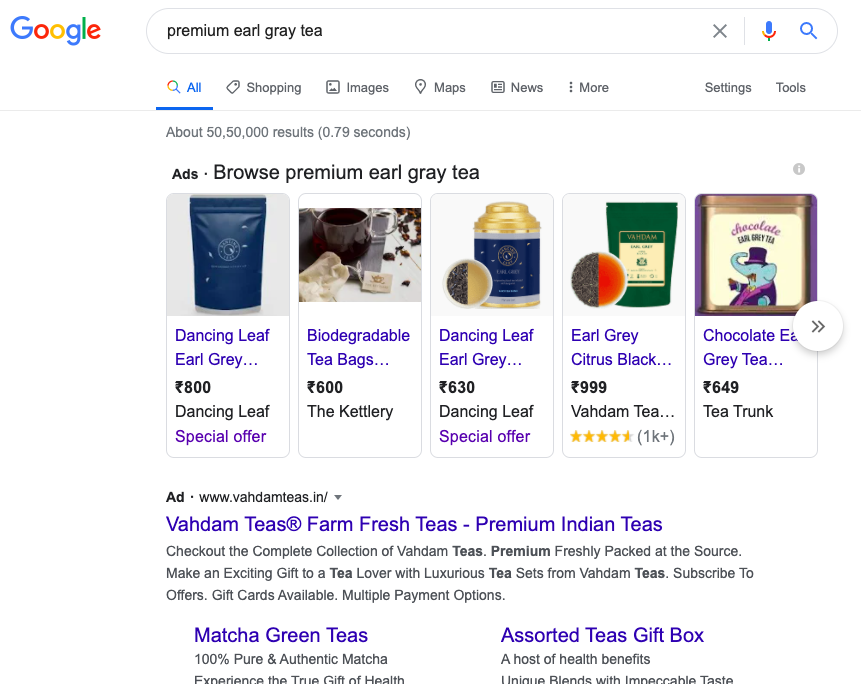
Notice in the screenshot that the top section from eCommerce websites are also advertisements. You can experiment with PPC but companies go for this only when they have four-five-six dollar figure budgets and more at which point you start seeing good results. People searching for those search terms will come across your ads and if your product is presentable and has good reviews, there’s a decent chance of a conversion. Of course, the buying decision becomes way more complex in B2B.
A question to ask is will the ads work? For software products, you can calculate the ROI with tools. For eCommerce and physical products, it’s not possible to tell how much ROI your ads will bring. There’s an interesting podcast by Freakanomics Radio which talks about whether advertising works or not.
3. YouTube
I know we already talked about social media but YouTube isn’t social media. Besides, videos have become such a large medium of content consumption that it deserves its own section. A catchy channel introduction, how-tos, showcasing your products, and educational videos could be your YouTube strategy to gain subscribers and more views. This option doesn’t make a lot of sense for local shops but works well for software and physical products. ERPNext also has a YouTube channel where we post videos. (Don’t forget to subscribe!)
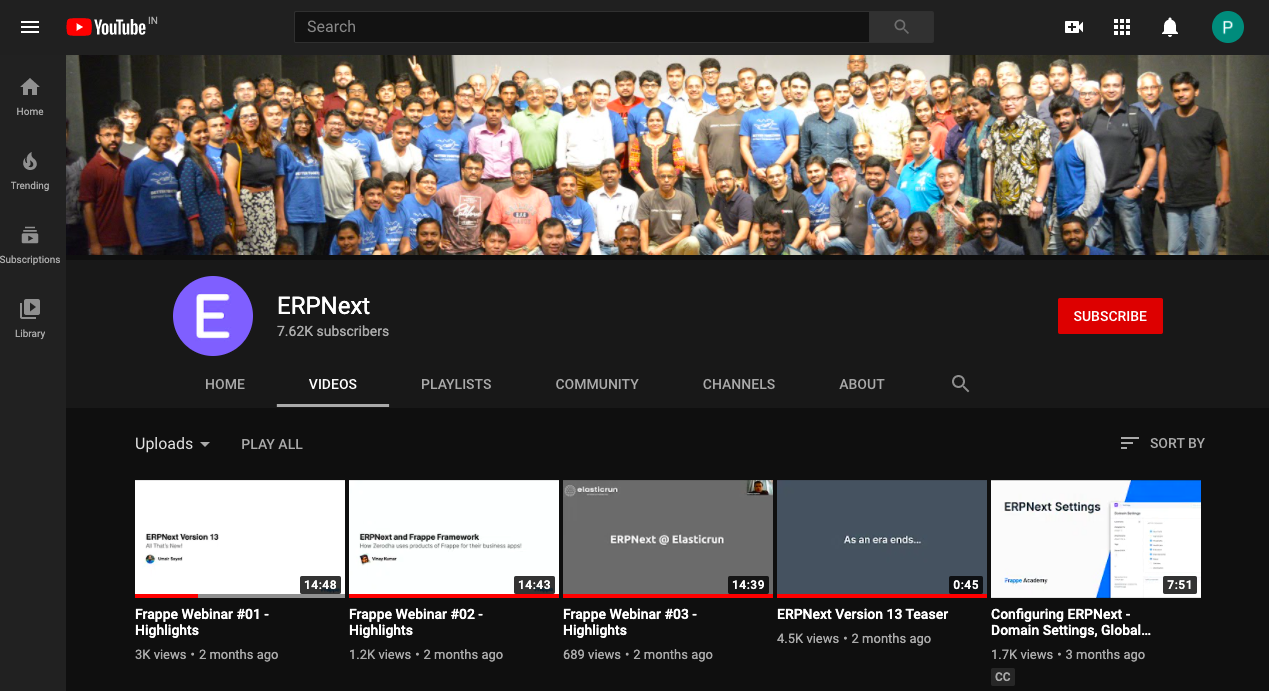
After you’ve put out a couple of videos, YouTube also shows useful stats about your viewers. YouTube is a great medium to engage and inform your audience with easy to consume content. The other part is advertising where you could go for paid promotions where you pay YouTube influencers to promote your product or run YouTube ads in related videos.
4. Promotions
Whether you’re a local shop handing out flyers and setting boards or a digital/eCommerce product setting up digital advertising, promotional offers always push over leads who are on the cliff of buying. If you’re a food stall, you could hand out flyers near colleges and offices. Beauty parlor? Hit your local yoga classes and vice versa. Similarly, for online promotions, target audiences who are likely to buy your products. They could be people who visited your website or people on your email list who aren’t customers or people who started a trial but never converted. While it’s not always the case, running promotions does nudge potential buyers into making a decision faster.
Promotions can be anything from 10% off on yearly subscriptions to buy 1 get 1 free. They’re an effective way for small businesses to drive more customers.
5. Hiring for marketing
Now if all this sounds like a lot of work it’s because it is. As a business owner, if you think this isn’t something for you or don’t have the time, you should look to hire a marketer with around five years of experience who can tackle many of these problems and get your marketing rolling.
6. Manage leads with CRM
After using one or more of these methods when you start getting leads at which point you need to manage them using a CRM system. Following up with leads, finding out their needs, mapping their requirements are all part of an elaborate sales process known as lead management. It’s done mostly in longer B2B engagements and software products.
7. Other ways
Let’s briefly talk about some other ways you can go about marketing your small business.
Brand building
This is a long term effort that includes having an amazing product, excellent service, and crafting branding messages via social media or other physical channels.
Newsletter
Sending a weekly or monthly newsletter with product updates and announcements or anything that might be useful to your audience builds a list of loyal subscribers. (like the ERPNext newsletter you should subscribe to)
Events/webinars
Conferences, webinars, live AMAs (ask me anything) are other strategies for companies and small businesses where you directly engage with your audience and form a connection.
Local listing
If you’re a local shop or business you definitely should do this. Go to Google Maps and mark your business. Add good pictures, addresses, contact info, timings, and all other information that makes it easy for people to contact you and know about your business.
5 tips for small business marketing
1. Identify your audience
One of the first steps you should take when approaching marketing is to know your audience. This is also known as a buyer or customer persona. Talk to your customers, know their likes and dislikes, what triggers them to buy solutions for their problems, understand their priorities, and so on. Once you have collected this information from different customers, create generalized personalities. This leads to creating customer personas. Depending on your market segments, one or 2-4 personas should be in your database. If you know your audience, you can market and sell to them much better.
2. Do you have a USP?
Does your business have a unique selling proposition? Superior product? Faster service? Additional services? Bring it up a lot in your communications if there’s one. It’s great to have a USP, makes it a bit easier to craft some messaging but don’t lose hope if you don’t have a USP. Quality and consistency go a long way. For example, ERPNext’s USP is super easy customizations that can be done with very little coding and time.
3. Get a logo and some basic design
Your first logo doesn’t have to be the best one and most likely it won’t be since your brand and company will evolve hopefully for the better over time. Just getting a logo done from a freelancer or agency gives more credibility, a visual aid to remember your brand. We’ll not go into detail about the logo, colors, and design here but it’s important to have if you’re setting up a website and social media accounts.
4. Can you do ads? What if you can’t?
A common dilemma when it comes to marketing and small businesses is the budget for paid advertising. Companies make the mistake of paying hollow agencies decent money just to manage Google ads! No content creation, no strategy! Well, it makes sense if you’re a larger company that can afford this but paying someone just to manage your ad metrics makes no sense if you’re a small business working on a limited budget.
So, back to the question. Google ads require a solid spend to reach broad audiences and figure out which regions and landing pages are working well for your company. This amount could easily be in thousands of dollars per month. If you’re cutting it close on other expenses by spending on PPC, don’t. An alternative is to spend on social media advertising which may not cost as much. If you’re a local business, well, flyers and newspaper advertisements are quite accesible.
5. Hiring freelancers
You may not find good marketing talent to hire easily when you’re starting. In that case, get freelancers but you get what you pay for. Many so-called blog writers lack depth and writing skills however you may find decent copywriters and video makers. Remember that this is what you’re putting out to the world to see. If you pay a subpar copywriting agency subpar money, you’ll get a lousy landing page that may or may not convert. Good ad agencies can charge anywhere from $5,000 and upwards to six figures for a project depending on your budget and what you want to get done. I will not recommend names here but I’m sure you’ll find good ones with a couple of Google searches.
Small business marketing decision framework
You must’ve seen many XYZ for small business marketing blogs online. So did I and thought the same thing you did, where do I start? Here’s a decisive framework to give you a rough idea of what you should be doing next.
But before that here are interesting stats you should know. According to a Visual Objects survey, “Only 21% of small businesses plan to use SEO in their marketing strategy in 2020 but 70% of them plan to increase social media investments.”
These are effective channels but some channels work better for certain businesses. Let’s take a look:
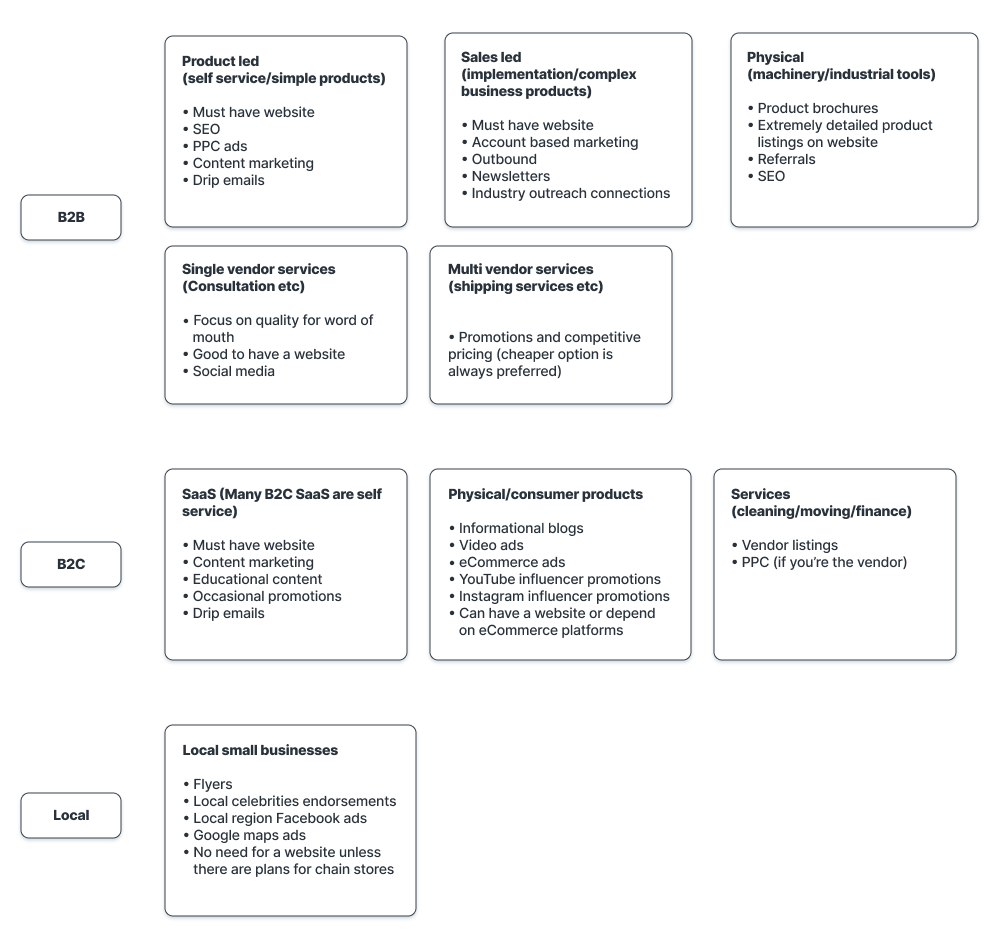
Creating marketing campaigns for small business with ERPNext
Say you’ve built up an email list with subscribers who want to hear from you either in the form of monthly or weekly newsletters. Or they just downloaded something or signed up for a free trial. Let’s say that you’re selling fruit infused tea bags. Business is alright but could be a lot better, so what do you do? Discounts with promotions and campaigns. Considering your budget you could run your promotions to your existing email list, social media advertising, or offer free samples with another popular product. Now, let’s see the different ways to handle campaigns and other marketing efforts in ERPNext.
Email campaign
You can set up a campaign with email templates to be sent at specific intervals. Within a campaign right now you can do emails with start and end dates like this:
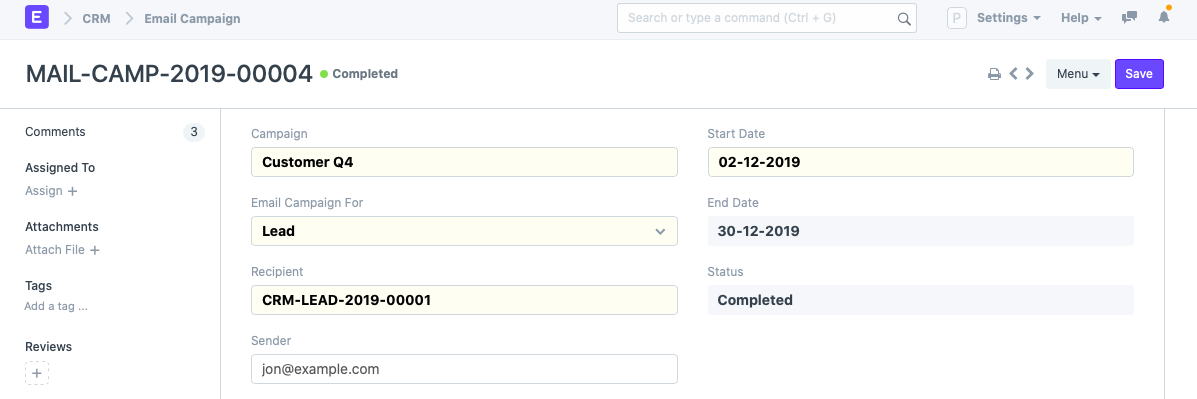
You can choose specific leads, contacts, or email groups to which the emails from the campaign will be sent.
Newsletter
You can send out a monthly or weekly newsletter with company and product updates.
Here’s an example of the ERPNext Newsletter in which we do that:

Newsletters are sent to email groups.
Email groups
Email Groups help to categorize audiences and to simplify sending emails to groups. There can be email groups of leads, opportunities, customers, contacts, region-wise leads, sales partners,
Campaign efficiency
In this report, you can see the conversion rates from leads to opportunities to customers after running a campaign. There are columns for lead ad opportunity counts, the order count, and conversions percentages.

Social media posting
With the Social Media post feature, you can create one document in ERPNext and choose to post it immediately or schedule it to be posted later. There is support for Twitter and LinkedIn in the upcoming v13, Facebook will be added soon.
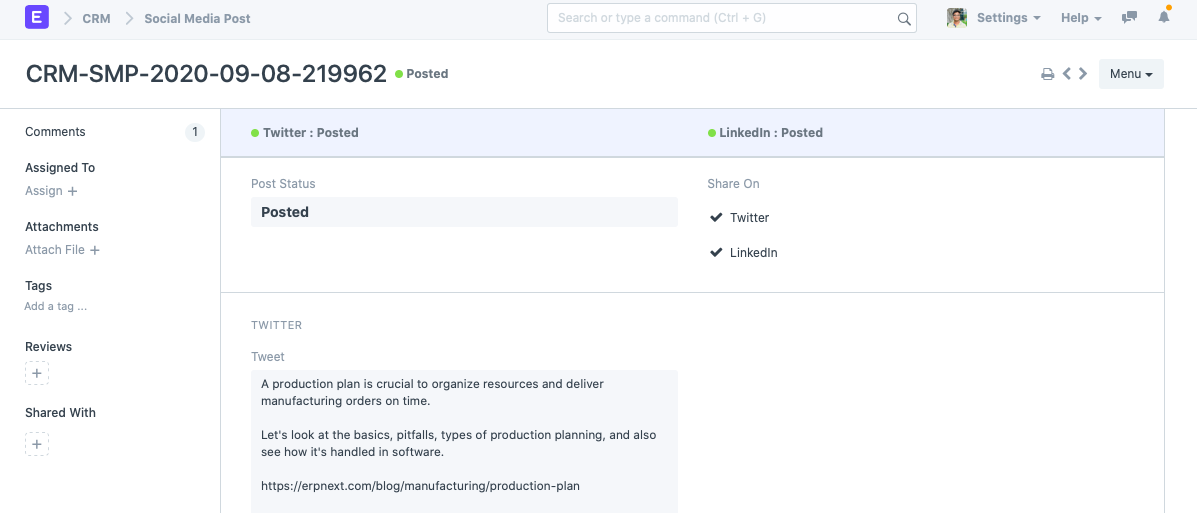
Starting a blog
One of the most effective ways to engage and attract an audience is to write good blogs that are useful to readers. Coming back to the tea example, you could write about the benefits of fruit infused tea, or green tea, or milk and sugarless tea in general. When writing blogs, SEO is important to ensure that people are searching for what you’re writing about. However, obsessing over it too much in the beginning will affect your content’s quality. So write a few blogs over a couple of weeks then learn about SEO and try to optimize your old and new blogs. Google ads keyword explorer is a free tool to look up keywords which is quite basic but should be good enough to start with.
For example, you want to sell your ‘apple infused tea’, you could write on topipcs like ‘benefits of apple infused tea’, ‘apple vs grape tea’, ‘is apple tea better than green tea’, etc.
Capturing leads with forms
By creating web forms, you can capture contact information from interested buyers and seed them to your lead list. Here’s the ERPNext contact us form:

If you’re interested in ERPNext and fill out this form, a lead will be created in our internal ERPNext instance and one of our representatives will get in touch with you to understand your needs.
When should you start marketing in your small business?
If you’re a 10-20 employee company just starting out and still working on your product, it’s natural to think that marketing isn’t necessary yet. This is partly true and you’re probably better off investing more to make the product or business fundamentals stronger. Once you have a decent sales team set up to handle incoming leads, starting off with marketing efforts makes sense to increase the flow of incoming leads. Whenever you choose to start, don’t forget that you need to know your potential buyer audience for marketing efforts to make sense.
Conclusion
There you have it. Now you should be familiar with the terms, methods, and ways you can approach marketing your small business. This was a decent introduction to the different kinds of marketing efforts. What is your business and which ones are you going to try?
Prasad Ramesh
Marketing at Frappe.
Thanks for sharing. www.cravingcatch.co.uk
@Chirag Mehta, thank you for the kind comment! Glad to know that the blogs are useful.
@Prasad Ramesh, You Always try to give idea about concept and ongoing scenarios and followed by simple steps available in ERPNext. Helps a lot for new executives in this domain. thanks for such content.